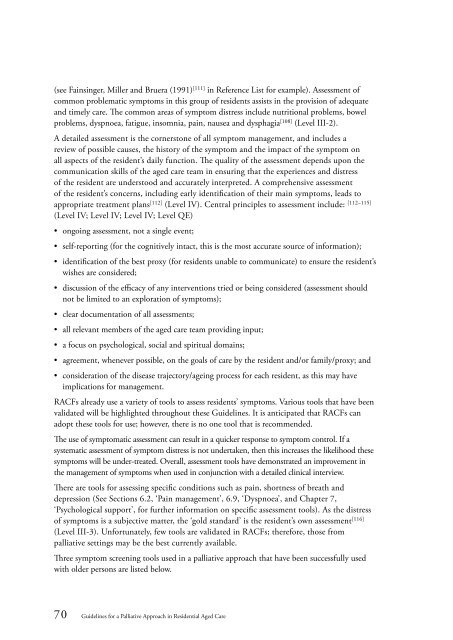Guidelines for a Palliative Approach in Residential Aged Care
Guidelines for a Palliative Approach in Residential Aged Care
Guidelines for a Palliative Approach in Residential Aged Care
You also want an ePaper? Increase the reach of your titles
YUMPU automatically turns print PDFs into web optimized ePapers that Google loves.
(see Fa<strong>in</strong>s<strong>in</strong>ger, Miller and Bruera (1991) [111] <strong>in</strong> Reference List <strong>for</strong> example). Assessment of<br />
common problematic symptoms <strong>in</strong> this group of residents assists <strong>in</strong> the provision of adequate<br />
and timely care. The common areas of symptom distress <strong>in</strong>clude nutritional problems, bowel<br />
problems, dyspnoea, fatigue, <strong>in</strong>somnia, pa<strong>in</strong>, nausea and dysphagia [108] (Level III-2).<br />
A detailed assessment is the cornerstone of all symptom management, and <strong>in</strong>cludes a<br />
review of possible causes, the history of the symptom and the impact of the symptom on<br />
all aspects of the resident’s daily function. The quality of the assessment depends upon the<br />
communication skills of the aged care team <strong>in</strong> ensur<strong>in</strong>g that the experiences and distress<br />
of the resident are understood and accurately <strong>in</strong>terpreted. A comprehensive assessment<br />
of the resident’s concerns, <strong>in</strong>clud<strong>in</strong>g early identification of their ma<strong>in</strong> symptoms, leads to<br />
appropriate treatment plans [112] (Level IV). Central pr<strong>in</strong>ciples to assessment <strong>in</strong>clude: [112–115]<br />
(Level IV; Level IV; Level IV; Level QE)<br />
• ongo<strong>in</strong>g assessment, not a s<strong>in</strong>gle event;<br />
• self-report<strong>in</strong>g (<strong>for</strong> the cognitively <strong>in</strong>tact, this is the most accurate source of <strong>in</strong><strong>for</strong>mation);<br />
• identification of the best proxy (<strong>for</strong> residents unable to communicate) to ensure the resident’s<br />
wishes are considered;<br />
• discussion of the efficacy of any <strong>in</strong>terventions tried or be<strong>in</strong>g considered (assessment should<br />
not be limited to an exploration of symptoms);<br />
• clear documentation of all assessments;<br />
• all relevant members of the aged care team provid<strong>in</strong>g <strong>in</strong>put;<br />
• a focus on psychological, social and spiritual doma<strong>in</strong>s;<br />
• agreement, whenever possible, on the goals of care by the resident and/or family/proxy; and<br />
• consideration of the disease trajectory/age<strong>in</strong>g process <strong>for</strong> each resident, as this may have<br />
implications <strong>for</strong> management.<br />
RACFs already use a variety of tools to assess residents’ symptoms. Various tools that have been<br />
validated will be highlighted throughout these <strong>Guidel<strong>in</strong>es</strong>. It is anticipated that RACFs can<br />
adopt these tools <strong>for</strong> use; however, there is no one tool that is recommended.<br />
The use of symptomatic assessment can result <strong>in</strong> a quicker response to symptom control. If a<br />
systematic assessment of symptom distress is not undertaken, then this <strong>in</strong>creases the likelihood these<br />
symptoms will be under-treated. Overall, assessment tools have demonstrated an improvement <strong>in</strong><br />
the management of symptoms when used <strong>in</strong> conjunction with a detailed cl<strong>in</strong>ical <strong>in</strong>terview.<br />
There are tools <strong>for</strong> assess<strong>in</strong>g specific conditions such as pa<strong>in</strong>, shortness of breath and<br />
depression (See Sections 6.2, ‘Pa<strong>in</strong> management’, 6.9, ‘Dyspnoea’, and Chapter 7,<br />
‘Psychological support’, <strong>for</strong> further <strong>in</strong><strong>for</strong>mation on specific assessment tools). As the distress<br />
of symptoms is a subjective matter, the ‘gold standard’ is the resident’s own assessment [116]<br />
(Level III-3). Un<strong>for</strong>tunately, few tools are validated <strong>in</strong> RACFs; there<strong>for</strong>e, those from<br />
palliative sett<strong>in</strong>gs may be the best currently available.<br />
Three symptom screen<strong>in</strong>g tools used <strong>in</strong> a palliative approach that have been successfully used<br />
with older persons are listed below.<br />
70 <strong>Guidel<strong>in</strong>es</strong> <strong>for</strong> a <strong>Palliative</strong> <strong>Approach</strong> <strong>in</strong> <strong>Residential</strong> <strong>Aged</strong> <strong>Care</strong>
















